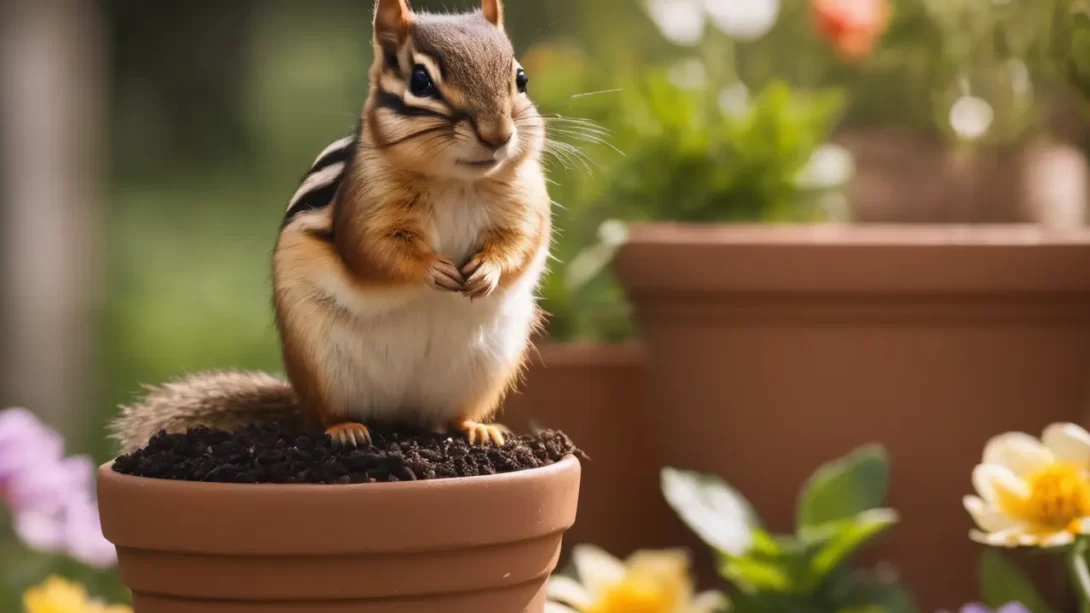Garden enthusiasts often find themselves at odds with chipmunks, particularly when these adorable yet pesky creatures take a liking to their flower pots. While chipmunks can add a touch of wilderness charm to your garden, their presence isn’t always welcome. They dig up bulbs, eat flowers, and can cause significant damage to your potted plants. Understanding and addressing this issue effectively and humanely is key to maintaining both the beauty of your flower pots and the health of their residents.
Chipmunks
Chipmunks: Small, striped rodents that are commonly found in gardens. They are known for their cheek pouches and lively behavior. Chipmunks are typically attracted to gardens for food, shelter, and nesting sites. They often find flower pots to be ideal places for these activities, leading to conflicts with gardeners.
Attraction to Gardens: Chipmunks are drawn to areas where they can find food and nesting materials. Gardens, especially those with flower pots, provide an abundant supply of seeds, bulbs, fruits, and insects, making them attractive to these creatures.
Humane Treatment: It’s important to address chipmunk invasions without harming them. Chipmunks play a role in the ecosystem, such as dispersing seeds and aerating the soil. Therefore, finding non-lethal methods to keep them at bay is crucial.
Preventive Measures
Cleanliness: Maintaining a clean garden is the first step in deterring chipmunks. This means regularly removing fallen fruits, seeds, and nuts, which can attract chipmunks to your flower pots.
Chipmunk-Resistant Plants: Certain plants are less appealing to chipmunks. Examples include daffodils and alliums, which tend to be avoided by these animals. Integrating such plants into your flower pots can naturally keep chipmunks at bay.
Physical Barriers: Creating physical barriers can be effective. This can include fencing around your garden area or placing your flower pots in enclosed spaces like patios or screened porches where chipmunks cannot easily access them.
Natural Repellents
Using natural repellents is a safe and environmentally friendly way to keep chipmunks away from your flower pots. These methods are non-toxic to plants, animals, and humans, making them ideal for gardeners who prefer organic solutions.
Peppermint Oil: Chipmunks dislike the strong smell of peppermint. Soak cotton balls in peppermint oil and place them around your pots. Be sure to replace them every few days, especially after rain.
Cayenne Pepper and Garlic: Mixing cayenne pepper or garlic with water and spraying it around the pots can deter chipmunks. These strong scents are unpleasant to them, but harmless to your plants. Regular application is key for continued effectiveness.
Frequency and Best Practices: Consistency is crucial. Reapply natural repellents every few days and after heavy rainfalls. It’s also a good idea to rotate between different types of repellents to prevent chipmunks from getting used to a particular scent.
Physical Barriers and Deterrents
In addition to repellents, physical barriers can provide a more long-term solution to keeping chipmunks out of your flower pots.
Hardware Cloth or Mesh: Covering the soil in pots with hardware cloth or fine mesh can prevent chipmunks from digging. Ensure the mesh is secured around the edges to stop chipmunks from lifting it.
Physical Barrier Around Flower Pots: Surrounding your pots with a barrier like rocks or bricks can discourage chipmunks from approaching. This method can also add an aesthetic element to your garden.
Motion-Activated Sprinklers or Ultrasonic Deterrents: Devices like motion-activated sprinklers can startle and deter chipmunks without causing harm. Ultrasonic deterrents emit a high-frequency sound that is unpleasant to rodents but inaudible to humans.
Chipmunk-Proofing Your Flower Pots
Making your flower pots less inviting to chipmunks can go a long way in preventing their visits.
Pot Design: Choose pots with smooth, high sides, which are more difficult for chipmunks to climb. Avoid pots with textures or features that provide easy grip.
Regular Maintenance: Keep the area around your flower pots clean and free of debris, which can attract chipmunks. Trim any overhanging branches or shrubs that chipmunks could use to access the pots.
Commercial Repellents: If natural methods aren’t effective, consider safe commercial repellents. These products usually contain ingredients like predator urine that scare away chipmunks. Always follow the manufacturer’s instructions for safe and effective use.
Balancing Chipmunks and Garden Health
While keeping chipmunks out of flower pots is a common goal for gardeners, it’s also important to recognize the role these animals play in the ecosystem. Understanding and balancing their presence can lead to a healthier, more vibrant garden environment.
Ecological Role of Chipmunks: Chipmunks contribute to the ecosystem by dispersing seeds and aiding in soil aeration. Their activities can help in the natural cycling of nutrients and support plant growth.
Creating a Wildlife-Friendly Garden: Instead of aiming to completely eliminate chipmunks, consider designing a garden that allows for some level of coexistence. This could involve designating certain areas where chipmunks can forage without disturbing your flower pots.
Harmless Deterrence: Always prioritize methods that deter chipmunks without harming them. Remember, the goal is to redirect their activities away from your flower pots, not to eliminate them from your garden entirely.
Conclusion
Successfully keeping chipmunks out of flower pots involves a combination of preventive measures, natural repellents, physical barriers, and an understanding of these creatures’ role in the ecosystem. It’s often most effective to employ multiple strategies in tandem. Experiment with different approaches to find what works best for your specific garden situation.
Remember, gardening is not just about maintaining plants; it’s about fostering a harmonious environment where all elements, including wildlife, can coexist. By adopting these humane and effective methods, you can enjoy the beauty of your flower pots and the overall vitality of your garden without the undue stress of chipmunk damage.




